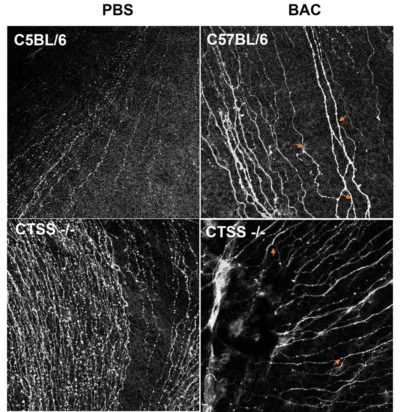
Staining of corneal nerves with β3-Tubulin in cornel whole mounts in mice wildtype (C57BL/6) and Cathepsin S knockout (CTSS-/-) mice, treated with 0.075% Benzalkonium chloride (BAC). Images were acquired in the central cornea using tiled confocal microscopy. Red arrows mark acute angles indication neural damage. Less acute angles are observed in BAC treated CTSS-/- mice than in WT mice.
Dry Eye (DE) is a prevalent disorder of the ocular surface, causing ocular pain and discomfort, affecting millions of people worldwide. The DE diagnosis includes signs and symptoms of ocular dryness that may be caused by a range of underlying conditions. Discomfort and pain are the most common reasons for seeking treatment for DE as they severely impact the patient’s quality of life and productivity.
However, these symptoms of DE correlate poorly with clinical signs, such as reduced tear flow, and ocular surface irregularity and some patients exhibit severe symptoms with few clinical signs. In these patients, corneal neuropathic pain may be a factor. Unfortunately, treatment options for DE patients with neuropathic pain are few and often insufficient.
Traditional DE treatments which restore moisture and regular pain medications in neuropathic patients/ Cathepsin S (CTSS), a protease with critical functions in inflammation, is crucial regulator of neuropathic pain outside of the eye. The neurobiological processes leading to corneal neuropathic symptoms are so far poorly understood. However, it is well known that inflammation and immune-neural interactions occurs after an injury to a peripheral tissue, where the immune response modulates neural responsiveness and nociception. These processes are essential in the development of neuropathic pain. In these conditions, Cathepsin S acts both at the site of injury and in the Central Nervous System (CNS).
Using Benzalkonium chloride, a preservative commonly found in eye drops, known to cause neuroinflammation and dry eye symptoms, as well as Cathepsin S knock out mice, Dr. Maria Edman’s team is investigating the role of Cathepsin S in corneal neuropathic pain and the therapeutic potential of Cathepsin S inhibitors to treat this condition.